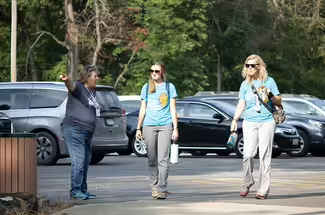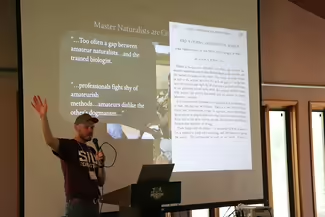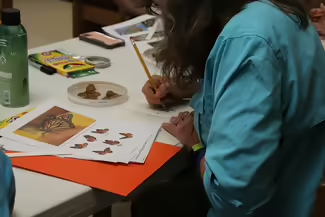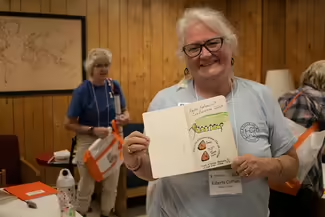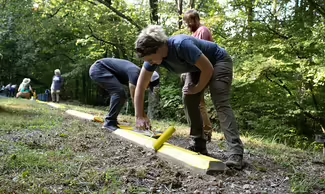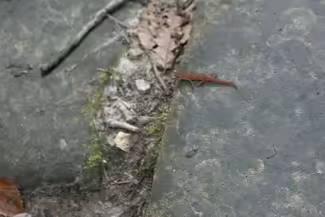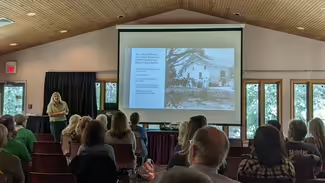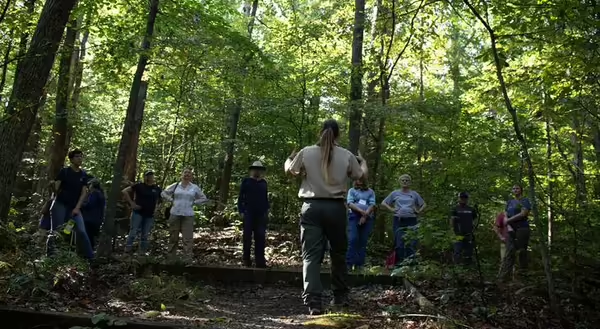
Every fall, nature lovers from around the state lace up their hiking boots and head out into the field for the annual Master Naturalist State Conference. The gathering is a chance for Illinois Extension staff and volunteers to share ideas and gain new skills, tools, and programs they can bring home to share with their local communities.
Last week, more than 100 people enjoyed the bluffs, forests, and lakes of Southern Illinois’ natural landscape at this year’s conference hosted at Touch of Nature in Makanda, Ill.
The keynote speaker was the Illinois Botanizer himself – Chris Benda. A naturalist, photographer, author, and teacher, Benda shared his passion for natural areas of Illinois and slide after slide of striking plant photos. He spoke enthusiastically about his work surveying plants, from small populations of rare and threated plants to record-breaking trees on the Illinois Big Tree Register.
After, participants explored sessions on a variety of topics: Bird watching, plant identification, climate change, inclusivity, and more. Two of the sessions – citizen science and archaeology and abolitionists – are covered in detail below. The second day of the conference, participants headed out on a field trip and service project of their choosing to explore Snake Road, hike Pomona Natural Bridge, tour SunnySide Acres native seed farm, canoe Lake Murphysboro State Park, or go rock hunting at Millstone Bluff.
Learn more about how to become an Illinois Master Naturalist and bring positive change to your community’s natural areas.
Citizen scientists make real-world change
Bird populations have declined by 2.9 billion since 1970. How do we know? Through citizen science, which has been making a meaningful impact on wildlife conservation for many years.
Dating back to 1900, the Audubon Society proposed a new holiday tradition—a "Christmas Bird Census" that would count birds during the holidays rather than hunt them. Each winter, individuals continue the tradition of the Christmas Bird Count, making it one of the longest-running citizen science projects on record.
Through citizen science, participants use a standardized sampling protocol for comparison, and the data is shared publicly to make real-world conclusions. Anyone can participate, and no formal background in science or discipline is required. Many Illinois Master Naturalists participate in or coordinate citizen science projects in their communities.
Brent Pease, Ph.D., is a wildlife biologist and assistant professor at Southern Illinois University. During the state Master Naturalist conference, Pease spoke on the importance of citizen science in scientific inquiry and the discovery of new knowledge. With rapid urbanization and global change, worldwide participants must synchronize their research and data collection efforts.
"Scientists are limited, but there are many citizen scientists," Pease said. "The scale of problems we are now facing is global, so we need folks all over the world coming together to work out some of these problems."
Pease discussed ongoing projects, such as Eclipse Soundscapes, a partnership with NASA to collect multi-sensory observations and recorded sound data to study how eclipses affect life on Earth during the October 14, 2023, annular solar eclipse and the April 8, 2024, total solar eclipse. To learn more about current citizen science projects conducted by Pease, visit peaselab.com.
The Underground Railroad in Southern Illinois
Nature and history often intersect. In Southern Illinois, one of those intersections may be part of the Underground Railroad.
Archaeologist Heather Carey who works for the Shawnee National Forest Service presented about her work uncovering the life histories of free African Americans living in Pope County pre-Civil War. From the 1840s to 1920s, Miller Grove was a small community of about 50 freed enslaved people originally from Tennessee who relocated to what is now the Shawnee National Forest.
Often the only information available about people of color in this time period is names, date of birth, and when someone moved. But history leaves other clues – in the form of letters, newspaper articles, and oral histories.
By reviewing these different lines of evidence, historians have pieced together a theory that Miller Grove was part of the Underground Railroad. “That’s something really hard to prove,” Carey said. “People didn’t write about the Underground Railroad, and when you’re basing your research on historical documents you have to read between the lines sometimes.”
Carey noted that there are several planned African American communities in other border states also located around 10 miles from the Ohio River. Miller Grover is in a remote, rugged area. That location would keep people safe from slave hunting parties.
Interviews with surviving family members point to oral histories of people lighting fires for the smoke to guide escaped enslaved people and leaving out food and clothing for those sheltering in Sand Cave.
James M. West, a white abolitionist who worked for the American Missionary Association and moved to Pope County to spread anti-slavery doctrine, wrote many letters with text about “railway facilities.” This was a common code for the Underground Railroad.
Carey hopes to continue the Shawnee National Forest’s work researching African American history and race relations in Southern Illinois and commemorate Miller Grover on a national register of Underground Railroad sites.
Several of the Master Naturalists asked about the plant communities at the archaeological digs, because old undisturbed pioneer cemeteries and communities often host rare and native plants. Carey said she would have botanists survey the sites and local Master Naturalists offered to come out and assist with identification and cleanup.
Photos: By Emily Steele and Heather Willis
MEET THE AUTHORS
This guest post to the Naturalist News blog was written by Emily Steele and Heather Willis, who are Illinois Extension communications professionals who attended the conference. Emily Steele is a media communications manager on Illinois Extension’s state marketing and communications team. She is a skilled communicator with more than 15 years of experience in storytelling that pairs well with a M.S. in Natural Resources and Environmental Sciences. Heather is a marketing and communications program coordinator for Franklin, Jackson, Petty, Randolph and Williamson counties in Southern Illinois. She develops advertising and publicity for unit activities including flyers, press releases, monthly impact reports and annual impact reports as well as web-based content.
